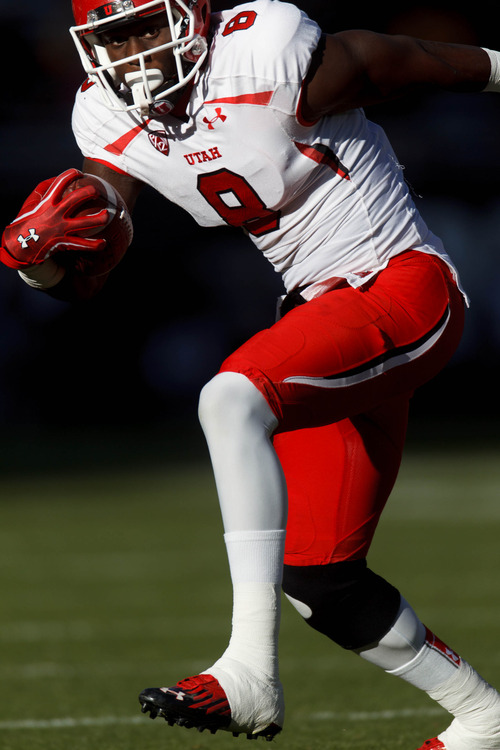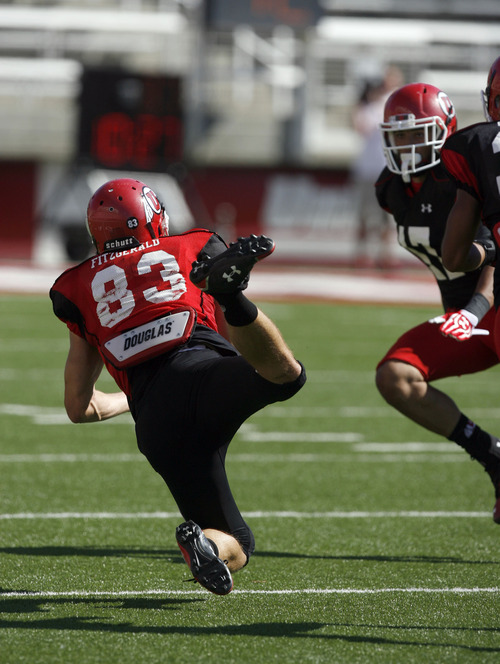This is an archived article that was published on sltrib.com in 2013, and information in the article may be outdated. It is provided only for personal research purposes and may not be reprinted.
Utah coach Kyle Whittingham, co-offensive coordinator Dennis Erickson and passing game coordinator Aaron Roderick all have been consistent in discussing Utah's depth at receiver this year.
The Utes have two solid guys in Kenneth Scott and Dres Anderson and then … well, the Utes are still waiting to see who can step into that third spot.
For a team that promises to spread out the offense and use a lot of looks, the Utes are looking mighty thin at receiver.
Now more than halfway through camp, the lineup isn't much more decisive than it was when the team reported for camp on Aug. 4.
The Utes' latest hope, JC transfer Andre Lewis, missed most of the first week of camp with a hamstring injury.
In his absence, senior Anthony Denham has eased into the third spot, but the 6-foot-4, 222-pound Denham hasn't been so dominating as to solidify his position by any means.
Evidence of how tenuous the spot is: Whittingham believes Lewis can catch up to compete for a starting role despite missing so much of camp.
It would be difficult to find another position on the team where a newcomer could pull off a similar feat.
However, despite outward appearances, the Utes aren't as bad off as some might think, said Roderick.
The Utes have bodies, they are just young.
Freshman Delshawn McClellon (5-foot-9, 166-pounds) has had a good camp, and senior Sean Fitzgerald (6-3, 200) can be a reliable receiver if he stays healthy.
Freshman Brian Allen is also an up-and-coming receiver, and freshman Dominque Hatfield has had several good days to get noticed.
The Utes also plan to use freshman Troy McCormick in a slot role.
Roderick said he wasn't too worried that outside of Anderson and Scott, none of the receivers has much experience.
Fitzgerald played in nine games last year but had just four catches for 61 yards, and Denham played in 11 games but had just 11 catches for 135 yards.
"They played a fair amount and they know what we are doing," he said.
The Utes have used several combinations of receivers in recent years, a habit Roderick admitted was more out of a search for solid receivers than any scheme demand.
This year, he envisions using four receivers extensively. If it sounds like a small lineup, he compares his vision to what the Utes did in 2008 when Freddie Brown (77 receptions, 900 yards), Bradon Godfrey (56 receptions, 556 yards), Brent Casteel (43 receptions, 564 yards), Jereme Brooks (30 receptions, 331 yards) and David Reed (25 receptions, 427 yards) were used extensively.
As Utah fans know, the Utes did all right that year with the limited lineup and averaged 36.9 points a game.
"We had Aiona Key and John Peel on the bench and they were good players," Roderick said. "I'd like to find a core group of guys this year and keep them on the field as much as possible."
The Utes believe Anderson will be a big-play receiver much like Reed was, while Scott will create plenty of matchup problems with his 6-foot-3 frame.
Also this year, the Utes plan to use two-tight-end sets with Westlee Tonga and Jake Murphy among the most talented players the Utes have had at the position.
All in all, the Utes believe they have the receivers they need.
"We have a good group," Roderick said. —
Utah State at Utah
P Aug. 29, 6 p.m.
TV • FS1







